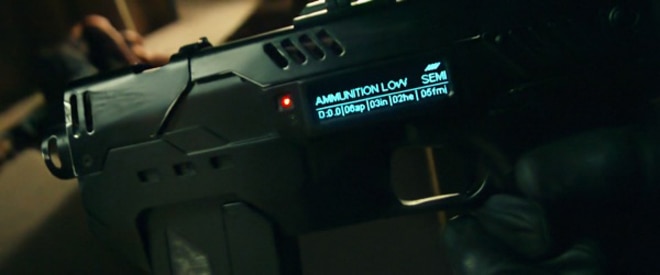
A fictionalized version of a smart gun. In the film Dredd, the character’s smart gun reads DNA and offers select-fire options. (Photo: Dredd)
The Federal Register opened up a commenting period Friday regarding the functionality and performance of smart gun devices for law enforcement officers.
According to the announcement, the National Institute of Justice has asked for public feedback on the generic baseline specifications for law enforcement service pistols.
The draft describes a handgun in question as a semi-automatic, recoil-operated, magazine-fed, striker-fired handgun chambered in 9mm Luger or .40 S&W. According to the government’s definitions, a smart gun is a device that will disable a firearm except for authorized individuals. Requirements for the safety device include an expansive list of wants, nots, and default settings.
The safety device can operate with an externally worn item, like a ring or wristband; programmed to authorize more than one operator; should covertly indicate when the pistol is ready to fire; and indicate low battery power.
The device should not inhibit the operator from firing in either hand; alter normal operating procedures; increase the time required to operate; and emit audible or visible signals.
As for the default settings, the government identified intentional or unintentional “electromagnetic interference” as a possible threat, so the device must be equipped with a countermeasure. If it uses batteries, they can be re-chargeable but shall be replaceable. Lastly, if the device malfunctions, it should default to a state that allows the pistol to fire and be easy for the operator to reset or disengage.
To receive a passing grade, the device must function without failure for at least 10,000 rounds and function without degrading in various forms of weather.
NIJ’s guidelines were based on a report by the Justice Department, Homeland Security and Defense Department conducted at the request of President Obama, who issued a memo on the topic of smart guns in January as part of a strategy to reduce gun violence.
Designers of such products see law enforcement as a gateway into the larger civilian market, but before that happens designs must be capable for the job. At a meeting on the topic in February, panels involved in both the technology and law enforcement expressed desire for many of the same performance standards.
Pro-gun organizations in recent times have not outright opposed the technology except in cases of mandatory applications for civilian gun owners.
To submit comments, send an email to gunsafetytechnology@usdoj.gov and address comments to Mark Greene, Office of Science and Technology, National Institute of Justice. The commenting period closes Sept. 13.
The government asks that you indicate the page number, section number, and the line number associated with each comment. Also, provide contact information with the submission.
For more information, check out the Notice and Request for Comments.
The post Minimum standards released for LEO smart guns appeared first on Guns.com.
